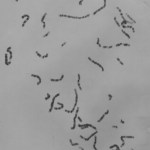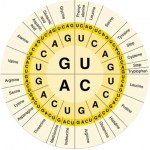proteins
Only 1% of the human genome codes for proteins, which might make you wonder what the rest of the nucleotide sequence is good for. In 2012 the Encyclopedia of DNA Elements (or ENCODE) announced that a full 80% of the genome played a biochemical role, interacting with proteins in some way. But a new study says it takes only about 8% of our non-protein-coding genes to make us human. This is the percentage of genes that are 'conserved' by the human species: change one of these genes, and you'll alter the fitness of the individual. These genes evolve slowly (although not as slowly as protein-…
Thanks to the internet, you can find out your pirate name and your Jersey Shore name, and now thanks to the EMBL-EBI learning tools, you can find your protein name too!
When you type your name into the box, the program reads the letters of your name as if they were the single-letter codes for amino acids. Since there are only 20 amino acids, if you have a B, J, O, U, X, or Z in your name the program reads it as "X" which just means any amino acid could go in that spot.
The amino acids are then translated back into one of the possible three-letter DNA codes for each amino acid, and that DNA…
tags: A Quick Peek at X-ray Crystallography at the Diamond Light Source, X-ray Crystallography, Diamond Light Source, proteins, Synchrotron, Van Morrison, wavelength, streaming video
This is a short video recorded on a trip to the Diamond Light Source by a group of Imperial College crystallographers. The video attempts to give a flavor of the strange things that they do to protein crystals when trying figure out the structures of the molecules within them. Music, "Wavelength", is by Van Morrison.
X-ray crystallography is a technique for determining the precise arrangement of atoms within a…
Since late 2006, honeybees in Europe and North America have been mysteriously disappearing. Once abuzz with activity, hives suddenly turned into honeycombed Marie Celestes. They still had plentiful supplies of honey, pollen and youngsters but the adult workers vanished with no traces of their bodies. The phenomenon has been dubbed colony collapse disorder (CCD). In the first winter when it struck, US hive populations crashed by 23% and in the next winter, they fell again by a further 36%.
Eager to avert the economic catastrophe that a bee-less world, scientists have been trying to find the…
Two protein structures from an avian influenza virus are shown below. One form of the protein makes influenza virus resistant to Oseltamivir (Tamiflu®)
Don't worry, these proteins aren't from H5N1, but they do come from a related influenza virus that also infects birds.
technorati tags: molecular models, protein structures, influenza, bioinformatics, Cn3D
One protein structure is from a strain that is sensitive to an anti-viral drug called "Tamiflu®". The other structure is from the same virus, except there's a slight difference. A single base change in the viral RNA changed the codon that…

